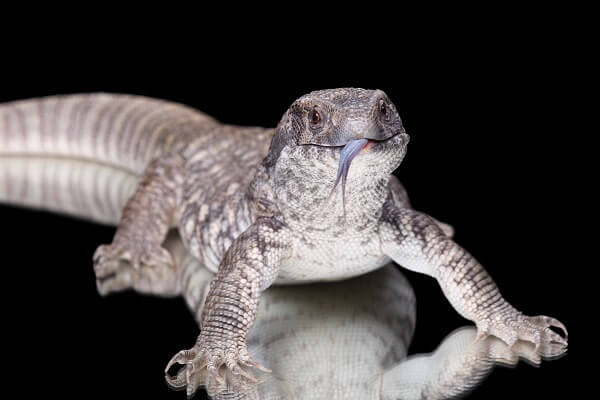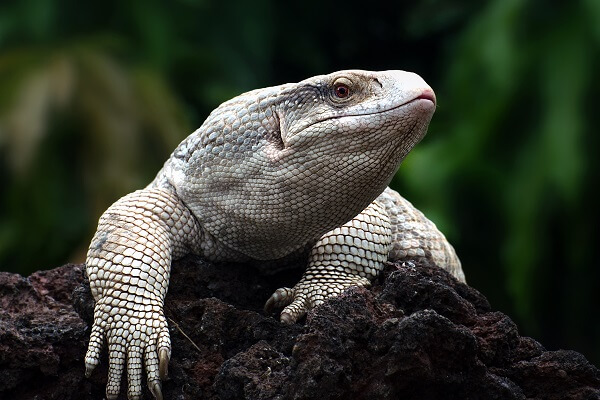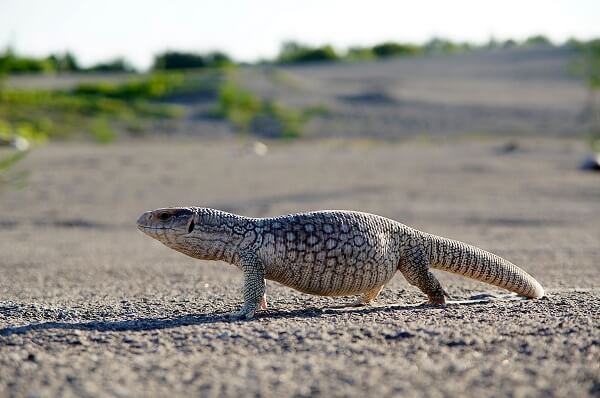
The savannah monitor (Varanus exanthematicus) is a medium-sized reptile found throughout most of Africa, south of the Sahara desert. These lizards are incredibly robust. They have powerful limbs that are used for digging burrows. They also have powerful jaws and blunt peg-like teeth that help them crush their prey. There are five subspecies, which is why the length and weight of these animals can vary so much. These lizards have large, grey scales with yellow or light brown patterns. They have a bright blue forked tongue. Savannah lizards are carnivores and prey on a wide variety of other animals, including small mammals, snakes, birds, beetles, snails, eggs, and other lizards. Like their name suggests, savannah monitors are usually found in savannah or grassland areas. They can also be found in rocky, semi-desert habitats, open forest, and woodlands. These giant lizards are primarily ground-dwelling and will dig burrows to live in. They are excellent diggers. Savannah monitors are also good climbers and are sometimes found in bushes or low hanging trees. Savannah lizards spend most of their time hunting or basking in the sun. They are solitary creatures and are very territorial. Males can be especially aggressive and will defend their territory by hissing and banging their tail on the ground. If their opponents refuse to leave, these lizards will try to chase them away and are not afraid to wrestle and bite them to protect their territory. They will also hiss and bang their tail on the ground when they feel threatened by predators. If this approach doesn’t work, then the lizards play dead. During the breeding season, males will pursue the females until they are ready to mate. The female produces 20 to 50 eggs and will bury them in a hole she has dug or in a termite mound. The eggs hatch during March and April. The hatchlings are around 4.7 in (12 cm) in length and weigh about a third of an ounce (10 grams). During the first couple of months, these lizards exhibit very rapid growth. Savannah monitor lizards are hunted and eaten by some snakes, birds, and humans. Humans will hunt them not only for their meat but also for their skins. These animals are also used in traditional medicine and exported for sale in the pet industry. This large carnivore has long fascinated biologists and has been the subject of numerous scientific studies that aim to understand how it survives in its environment. Researchers have uncovered several biological adaptations that are great examples of various biological concepts, some of which are yet to be fully understood. Let’s investigate further. Mammals, like you and I, breathe in a tidal flow pattern. This means that we inhale oxygen-rich air and breathe out air that has been depleted of oxygen, with air moving in both directions through the various compartments of the lungs. Birds breathe using a different mechanism where air moves in one direction through the lungs, enabling them to extract oxygen when both inhaling and exhaling. Previously it was thought that monitor lizards breathe using a tidal flow pattern like mammals, but recently researchers found that these lizards have lung structures that are somewhere between mammals and birds. Savannah monitor lizard lungs are structured around a long branchial tube, which ends in a big sac. The main tube has lots of smaller tubes that branch off from it and direct air into tiny chambers. These chambers have holes in their walls, and so air can travel from chamber to chamber. In some of the chambers, the airflow was like that of mammals, moving in and out, while in other chambers, the flow of air was unidirectional like that observed in birds. It’s a unique pattern that is part bird, part mammal. This research is relatively recent, and currently, it is not known why Savannah monitors breathe this way. As more research is carried out, it’ll be interesting to see how this biological adaptation is important to savannah monitors. These lizards are diurnal and most active in warm weather. In the colder months, these animals are inactive and don’t feed, and as such, their feeding pattern is known as feast and famine. The wet season lasts eight months, and during this time, there is plenty of food available. Savannah monitor lizards feast during this time, building up their fat reserves. They feast so much that they can consume 10% of their body weight in one day! In the dry season, when food is scarce, they remain inactive and live off of these fat reserves. Fat is stored in two organs located in the abdomen and can also be stored in the lizard’s massive tail. Savannah monitor lizards have blunt teeth and a powerful jaw. Teeth located at the back of the jaw have maximum leverage, which enables them to crack the shells of some of the prey species that they eat, such as snails. These reptiles have also evolved a way to eat poisonous millipedes. When the lizard locates a millipede, it will rub its chin along the millipede’s body for up to 15 minutes before eating it. The lizards are believed to do this to get the millipedes to excrete a fluid that it uses in its defense mechanisms. Once the supply of liquid is gone, then the lizards can eat the millipedes.
Kingdom
Animalia
Phylum
Chordata
Class
Reptilia
Order
Squamata
Family
Varanidae
Genus
Varanus
Species
Varanus exanthematicus
Niche
Carnivorous
Length
Variable, but can reach up to 6 ft (1.8m)
Weight
1 to 70 kg
Lifespan
8 – 13 years
Social Structure
Solitary
Conservation Status
Least Concern
Preferred Habitat
Grasslands and savannahs in eastern and southern Africa
Average Clutch Size
10 – 50 eggs
Diet
Small mammals, birds, snakes, toads, lizards, and eggs
Main Threats
Hunted by humans for food, traditional medicine, and pet trade
The Basics


Interesting Insights from the Savannah Monitor!
Breathing

Feast and Fast
Eating Adaptations
